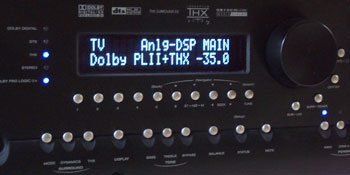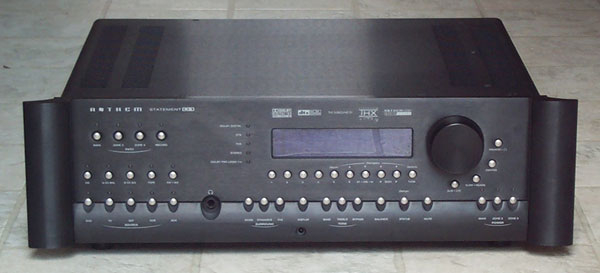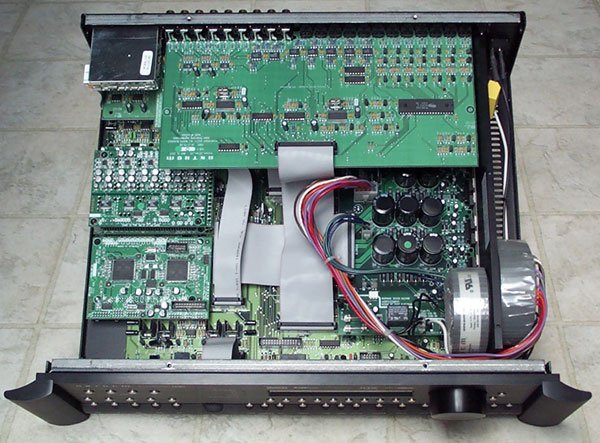|
||||||||
|
Introduction In December of 2001 I lavished Anthem's AVM-20 Processor with, if I may say, deserved praise. The folks at Anthem literally seemed to read my mind, and the minds of countless home theater enthusiasts as well. The AVM-20 brought us features we'd been begging for, introduced us to many we did not yet know we wanted, sounded better than anything we had ever heard, and was on the market for half the price of comparable units. The features were so numerous that Secrets set a new precedent for SSP reviews. The technical depth required to explore the product in its entirety exposed many aspects of SSP design that were being ignored by the press at large. Don't believe us? Think our enthusiasm is too much? Ask any AVM-20 owner. It would be almost two years ago now that Anthem first spoke of a subsequent product. Not a replacement for the AVM-20, but a model positioned above it. What on earth could they change or add? Anthem had been very up front about the fact that D1 would be very similar to the AVM-20 in form and function. Their intention was for the D1 to rise above its predecessor in the areas of audio quality specifically. For me, that calls to mind boutique audio joints which talk about "upgrading" or "mod'ing" something by replacing a couple capacitors with some magical hand made unit rolled by a seraph at Everest base camp. Nonsense say I. While we are assured by Anthem that every single component in the D1 (including those capacitors) are simply the best available for the task at hand, the real step forward in the D1 is in the digital domain. Serenity now. The D1 Design For the record, the D1 is ever so similar to its predecessor in terms of the back panel. Seven conventional analog stereo inputs are each augmented with coax digital audio, composite video, and S-Video. Two have complete sets of analog audio and video outputs to feed the record lines on those (or any) component. There are three Toslink (optical) digital inputs and one Professional AES/EBU digital input, all of which can be assigned to any of the previously mentioned seven basic inputs. There is a dedicated two-channel balanced input and a six-channel (5.1) single ended analog input. A quartet of component video inputs can be assigned to any audio line.
For outputs, complete 7.1 sets are provided in both single ended and balanced formats. Both include two jacks for the center and subwoofer (10 outputs per set total). Stereo audio, composite, and S-Video outputs are provided for Zone 2, Zone 3, and the Rec Path, while a pair of coax digital audio outputs are available with a variety of formatting options. Two component video outs are there as well. Despite the abundance of jacks, and the fact that at first glance it looks overwhelming, Anthem has kept the concept that worked so well on the AVM-20: All inputs are on a black background, while outputs are all on a white background. See below.
Anthem doesn't not quite have all the THX standard colors on their multichannel I/O jacks (there is no distinction between main, surr, and rear). I suppose I should be more upset with THX for being "loose" on this requirement as I know they are, but either way, I have to point it out. It is such a simple thing which time and time again I've been thankful for when making connections hunched over the back of a rack where labels are all but useless. There are three 12V trigger outputs (1/8" jacks), two infrared outputs (also 1/8" jacks), and a 12V terminal strip to power such things as IR receivers. A DB-9 RS-232 serial port serves not only as a vein for the D1 to communicate with whole home systems, but also opens up the D1's brains for software upgrades and changes. Although after all that, it seems banal, antenna terminals are there for the built-in AM/FM tuner. The only spot on the back not populated has been conspicuously labeled "IEEE-1394" (though as of this writing, that spot is not going to be blank for much longer). There are four independent zones (or paths if you prefer to think of it that way). The Main Zone is the full 7.1 channel layout. Zones 2 and 3 are completely independent 2 channel paths complete with volume and tone control. The 4th is the Record path, again, independent of all the others. Any source can be routed anywhere. That's where the resemblance to the AVM-20 ends. Under the hood things start to take on the different shape. In the D1 both the main power supply and stand-by power supply are torodial (the stand-by in the AVM-20 is a standard iron core). The D1 employs more than twice the computing power of the AVM-20, with a pair of Motorola 56367 DSP units running the show. While simply looking at the model of DSP and their MIPS provides no line on which to judge an SSP, it is a concern from the point of view that we don't know what's around the corner. It has been demonstrated how a new decoding scheme can put greater demands on an SSP's computer, or require a new one all together. No matter how many 56366 DSPs were in the AVM-20, it would take a 56367 to do Pro Logic II, but Anthem had the foresight to put the DSP section on a daughter card, making the swap necessary to go to version 2.0 a literal snap. The same physical layout exists in the D1, but I don't think we'll be replacing anything any time soon. Consider that with the twin Motorolas, the D1 can decompress a muti-channel bitstream, do full bass management on seven channels of 24/96 audio, and perform THX Ultra2 or Dolby Pro Logic IIx post processing. 'Nuff said. The D1 uses AK4395 DACs (Digital to Analog converters) and AK5494A ADCs (analogue to digital converters), both capable of up to 24bit/192kHz (though the ADCs are actually operated up to 24/96 only, something we'll explain later). The oh-so critical issue of output stages is answered by Anthem with the choice of BurrBrown OPA-2132 units all around. These were chosen over the OPA-2134 units used in the AVM-20 in part for their stability down close to DC.
Functionality This is where the rest of the industry was behind the AVM-20, and for the most part, no one's caught up. Both the AVM-20 and D1 are arguably the most complete SSPs on the market, yet if you ask any owner what they love most, the first thing that comes out of their mouth is, "It's so easy to use . . . it does exactly what I want". Naturally, time alignment gets set just the way we like it: By inputting the distance to each and every speaker in the system, in 0.5 foot increments. The AVM-20 introduced a new concept here which is carried into the D1: Specifying whether the surrounds are Dipolar or Direct. If you specify DiPole here, the D1 reduces the amount of delay applied because the sound of dipoles is thought to arrive "later" since it travels first to the boundaries of the room and then to our ears. From what we understand, this idea was run past THX and got their approval. We originally liked the idea but in the meantime, having consulted with Dolby, I'm encouraging you to first try the Direct setting, even if you have DiPoles. While it is true that much of a dipole's sound is reflected, some sound does come right from the enclosure. Depending on the acoustics of your room, that first direct sound may be of sufficient power and timber as to make conventional delay settings the appropriate choice. Each input has its own setup menu. Each can be renamed to anything you like up to six characters, can have any digital input assigned to it, or may be designated as analog, in which case you'll chose between converting it to digital or bypassing everything the D1 has to offer and leave it as analog (more on this later). Each input may have a global delay applied to it, in range of 0-170 ms, and each has an input gain, as well as its own unique Bass and Treble settings. In the case of digital, a given input can be set to use short, medium, or long muting. This is not referring to the general "Mute" button on the remote, rather it is the inherent mask of a digital audio system pending data stream lock. With some equipment and/or data types, the "short" setting may produce a "snap" or "pop" at the start of a stream (which includes chapter skipping because technically, that is an interrupt and restart of the stream). We found that the default for DVD players, the "Medium" setting, proved to have a small snap at the start of a DTS 24/96 stream with one particular DVD player (but it worked fine with any and all other digital audio formats). Changing this setting to the "Long" setting (the default for DSS systems), solved the problem at a slight cost of lock-on time. Each input has six signal formats to which default playback modes may be assigned:
You can, for example, set "Stereo" to be the default for two-channel audio, Pro Logic II Movie the default for Dolby Digital 2.0, and THX Ultra2 Cinema for the 5.1 formats. These choices can be unique to each input. The D1 has its own clock with time/day, offering a comprehensive set of timers. It can turn on every day at a preset time (30 minutes before you get home to warm everything up for example) and turn off every night at midnight (in case you forget to do it). The D1 presents DRC (Dynamic Range Control) very plainly as a cycle of Off, Reduced, and Late Night. A nice touch is that at power off, DRC always resets to Off. I like this a lot because there have been many times I've turned DRC on and forgotten that it is on. The next day I get halfway through a movie before realizing why the soundtrack sounds less than dynamic. The D1 (and the AVM-20) are to my knowledge the only SSPs which offer to do DRC on DTS material, forever dispelling the myth that such a thing is "just not done on DTS". DRC has always been an available option with DTS, the difference being that, where Dolby requires that a decoder offer the option, DTS never did. Note that the soundtrack author has to specify DRC parameters in the metadata of a DTS soundtrack, or this function will be benign. The Center EQ introduced in the AVM-2 has been carried forward. If used, it offers a simple choice of several TV sizes. Pick the one your TV fits into, and a filter is applied to the center channel to counter the chesty reinforcement the speaker tends to get from sitting on top a large flat surface.
Digitally
controlled analog volume control is now the norm in SSPs, but no one comes
close to exploiting the potential of it quite like Anthem. A default power-on volume level
may be specified for each of the three zones. We've already mentioned
that each input has its own gain trim. A maximum volume level can be set
(may I suggest for your safety you set it to "0 dB"), and at your option, the Mute button can either be
a total cut or an attenuation (your choice of -15 dB to -30 dB in 5 dB
increments).
The Pro Logic II Music non-mandatory adjustments are available to the user.
Panorama, Dimension, and Center Width can be set.
Similarly, DTS:Neo6's Center Image adjustment is available. To the best of
our knowledge the AVM-20 and D1 are the only Dolby Digital decoders on the
planet which read the Surr.Encode
flag in two-channel Dolby Digital. The original idea with Dolby was
that if the two channel
soundtrack is surround encoded, and the author set the flag properly, a
processor would automatically go into Pro Logic II Movie. The other flag settings are not surr encoded (where the SSP would go into stereo mode) and not specified (where the SSP would just stay in its current
mode). It's sort of a moot point at this time because content authors
did not embrace setting it properly, but I will continue to
point it out if for no other reason than to demonstrate how Anthem does a
thorough job, while most other companies have not bothered. As per THX requirements, the D1 attenuates DTS material by 4 dB, equating it with Dolby Digital material encoded with what was once the default Dialnorm value of -27. When Dolby Digital and DTS first came to consumers, this made sense as it put the two on the same level. Now, unfortunately, the industry has not stuck with their original way of doing things, and some studios are moving to a Dialnorm of -31 as their standard. What to do? Ultimately, if you don't care at all to know what your volume is relative to reference, none of this matters. For the rest of us, I can foresee asking companies like Anthem in the future to break the rules and start offering an option whereby the SSP will "re-normalize" AC-3 soundtracks to a -27 equivalent (in other words, apply the same -4 dB attenuation to -31 Dialnorm AC-3 material as is done to DTS) so that everything is on the same page. That's one idea anyway (and I admit, not a very good one).
All material is down-mixable to two-channel for the other zones, headphones, or
tape/CD recording. This includes all muti-channel digital formats as well as the 5.1 analog input. At the start of a bitstream, the display will show the difference in Dialnorm assertion with reference to -27. So for example, if you see "Dialnorm: +4 dB", that means the output of the decoder has been raised by 4 dB. Cycling through "Status" will show you such things as current software version, bitrate of the current bitstream, and output configuration. Go to Part I - Introduction, The Design, and Functionality Go to Part II - Speaker Setup, Bass Management, and Upsampling Go to Part III - On the Bench, The Sound, and Conclusions
|
||||||||
| u | ||||||||







